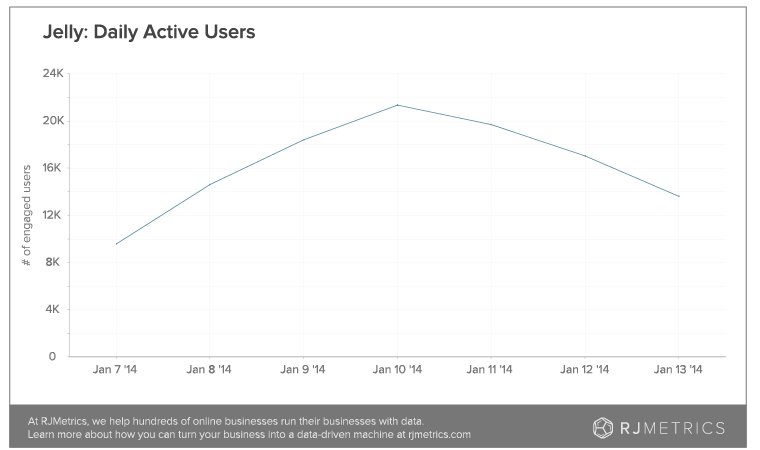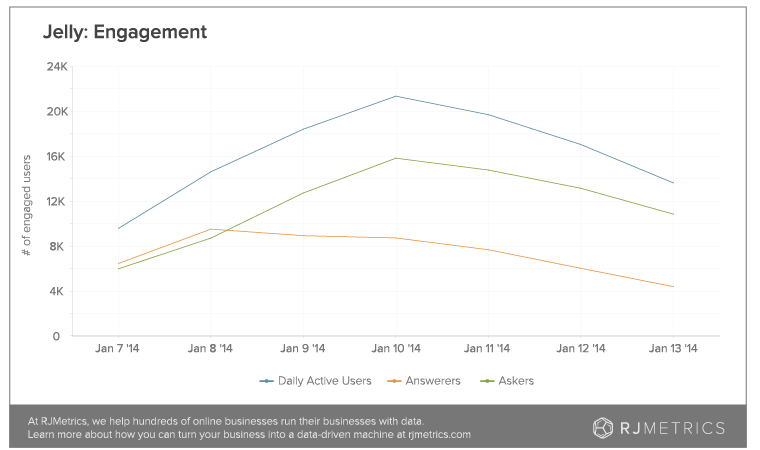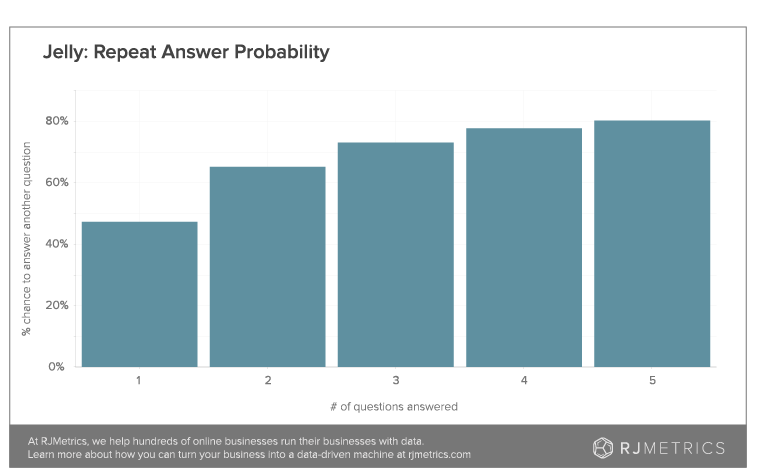Biz Stone’s new startup Jelly was launched with great fanfare one week ago today. Jelly is as ambitious as you would expect from a co-founder of Twitter: it aims to transform all smartphone-wielding humans into a single collective neurological entity.
Or, failing that, it’s a pretty fun question-and-answer app.
While I’m not qualified to assess Jelly’s ability to transform us into a benevolent overmind, I did manage to get my hands on quite a bit of data about how people are using the app. Since Jelly’s launch, I’ve been collecting data on all of the questions and answers that have been posted. If you’ve been curious what’s been going on, read on.

Note: My company, RJMetrics, has no affiliation with Jelly. All data was collected via my own Jelly account using publicly accessible (if undocumented) API endpoints, and then analyzed using RJMetrics. If you’d like to run this kind of analysis on your own business, sign up for a free trial of RJMetrics today.
Highlights
Usage:
- Over 100,000 questions were asked in Jelly’s first week.
- Only about 25% of questions received an answer.
- The daily active user count is trending downward as the post-launch buzz dies down.
- Each interaction with the app increases your likelihood of interacting again.
Content:
- While there are plenty of “Hello world!” questions being asked, most questions on Jelly are legitimate inquiries.
- The most common use case appears to be crowdsourced image recognition.
- All those users who asked “what does the fox say?” are not as original as they probably thought.
What’s everyone asking about?
My first Jelly-related curiosity was around what people were asking about. Since the photo is such a core element of the question, it wasn’t surprising to see that “What is this?” and “Who is this?” are the most popular questions. In fact, out of the top 10 questions posted, every single one of them was an image identification question: people asking their social networks to figure out who, what, or where something was.
| Question | Count |
|---|---|
| What is this? | 6,167 |
| Who is this? | 1,368 |
| What’s this? | 1,127 |
| What is it? | 646 |
| What is that? | 541 |
| Where am I? | 470 |
| Where is this? | 415 |
| What? | 410 |
| What’s that? | 226 |
| What kind of dog is this? | 175 |
Out of the over 100,000 questions asked in Jelly’s first week, just over half of them contained one of the words “who,” “what,” “why,” “where,” “when,” or “how.” Here’s the breakdown among those questions:

Again, this makes logical sense given the heavy photo component. Photos don’t lend themselves to “why” and “when” questions as much as they do “what” and “who” questions.
Other frequent questions that stood out:
- 44th Most Frequent: “What brand is this?” Perhaps an early hint about Jelly’s path to monetization?
- 59th Most Frequent: “Who am I?” Nothing like pairing an existential question with a casual selfie.
- 20th, 71st, 76th, and 81st Most Frequent: Species Identification People really wanted to know what kind of plant, flower, and dog they were looking at.
- 77th Most Frequent: “What does the fox say?”
Yes, 41 people asked “What does the fox say?” If you’ve seen the video, the most popular answers to that question shouldn’t be surprising:
- “Kakakakakkapowwwww”
- “Ringdingdingdingdingdingdingding”
- “Juba juba juba juba joo”
- “Hathi hathi hathi how”
Good luck finding those as your top four answers in a Google search. Maybe Jelly is really on to something…
Is Jelly going to catch on?
Jelly has first-week usage numbers that any startup would love to see. On its launch day (January 7th), it saw 8,275 new active users (defined as someone who asked or answered a question): 5,183 of them asked questions and 5,527 answered questions. In its first week, over 100,000 questions were asked.
Usage has dropped off a bit since the beginning, however, as shown in the daily active users chart below.

While the dropoff on the 11th and 12th could be explained away by the weekend (a typical lull for social activity), the continued downward trend on Monday the 13th is concerning. It could indicate that users aren’t sticking around after their first few days. Let’s dig in deeper to get the full story.
Asking vs. Answering
As a two-sided marketplace, it’s critical that Jelly maintain a healthy balance of askers and answerers. In the first two days, users seemed equally engaged on both sides of this equation. Over time, however, the number of people asking questions has outpaced those answering them.
 cohort analysis. In the chart below, each line represents the cohort of users who ask or answer their first question on a certain date. The value at each data point is the percentage of them who come back to ask or answer a question again each subsequent day.
cohort analysis. In the chart below, each line represents the cohort of users who ask or answer their first question on a certain date. The value at each data point is the percentage of them who come back to ask or answer a question again each subsequent day.
Lines like these typically drop off as shown here, particularly in a daily cohort analysis. That said, however, the more troubling trend is that with each subsequent cohort the rate of retention appears to be dropping:


The key to Jelly loyalty may be getting users to ask a second question. While only 16% of people who ask one question ever come back to ask a second one, that number jumps to over 30% once a second question has been asked and over 50% after a third. For a company that is only one week old, this is a rather impressive tendency.
Conclusion
It’s pretty hard to draw conclusions about a week-old company, but the one thing I know for sure is that Jelly has already succeeded in collecting a wealth of data about how people use their platform. If they’re anything like us, they’ll take full advantage of this data to maximize their chances for success.
Using RJMetrics, we were able to quickly identify the most common behaviors in the Jelly community. We were also able quickly drill down from a simple usage trend into some of the key issues that could challenge user adoption. If you’re interested in performing this kind of analysis on your business, try RJMetrics out today.
We’ll be keeping an eye on Jelly’s progress. Stay tuned and let us know if there’s anything else you’d like to see.

Pingback: Jelly Sees 100K Questions In First Week Says RJMetrics, Of Which 25% Received Answers | TechCrunch